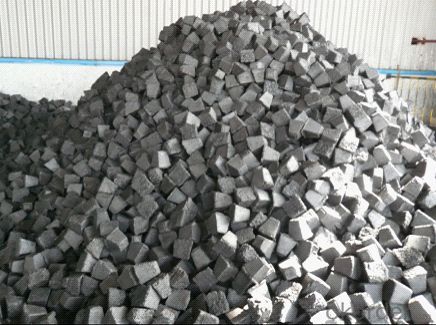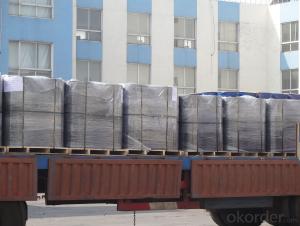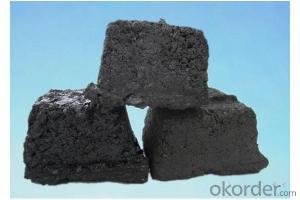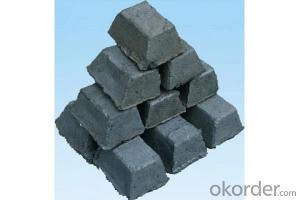Carbon Electrode Paste Cylinder Low Ash CNBM
- Loading Port:
- Tianjin
- Payment Terms:
- TT OR LC
- Min Order Qty:
- 0 m.t.
- Supply Capability:
- 20000 m.t./month
OKorder Service Pledge
OKorder Financial Service
You Might Also Like
Packaging & Delivery
| Packaging Details: | 1 mt bag or bulk package |
| Delivery Detail: | 15-30 days after we get the deposit or original L/C |
Specifications
Carbon Electrode Paste:
1)Low ash content
2)Good thermal conductivity
3)High resistance to temperature
4)Stable quality
Main Function And Features
1) Low ash content
2) Good electric and thermal conductivity
3) High resistance to temperature
4) Stable quality
5) Reasonable price
6) Size:all kinds of electrode paste
7) Accord customer's reques change
•Introduction To Products
1) Carbon Electrode Paste is a self-baking electrode used in submerged arc furnaces for delivering power to the charge mix.
2) Electrode Paste is added to the top of the electrode column in either cylindrical or briquette form.
3) As the paste moves down the electrode column the temperature increase causes the paste to melt and subsequently bake
forming a block of electrically conductive carbon.
4) Electrode Paste is essentially a mix of Electrically Calcined Anthracite (ECA) or Calcined Petroleum Coke (CPC) with Coal
Tar Pitch.
Application Range
1) Be used as the electrode for self roasting in the iron-alloy furnace and acetylene furnace.
2) Amorphous graphite powder--applied in steel making,fireproof material,casting coating.
3) Calcined petroleum coke--used in foundry,metallurgy,carbon paste,graphite electrode.
4) Carbon anode scrap--used as smelting fuel for copper smelting industry.
5) Carbon electrode paste--applied in iron alloy,calcium carbide,ferroalloy,ferromanganese.
•Main Technical parameters
Graphite/Carbon Electrode Paste
Specification/Item | |||||||
Ash | max | 4.0%max | 5.0%max | 6.0%max | 7.0% Max | 9.0% Max | 11.0% Max |
VM | % | 12.0%-15.5% | 12.0%-15.5% | 12.0%-15.5% | 9.5.0%-13.5% | 11.5%-15.5% | 11.5%-15.5% |
Compress Strength | Mpa Max | 18.0Mpa Min | 17.0Mpa Min | 15.7Mpa Min | 19.6Mpa Min | 19.6Mpa Min | 19.6Mpa Min |
Specific Resistance |
μΩm Max | 65μΩm Max | 68μΩm Max | 75μΩm Max | 80μΩm Max | 90μΩm Max | 90μΩm Max |
Bulk Density | G/CM3 Min | 1.38G/CM3 Min | 1.38G/CM3 Min | 1.38G/CM3 Min | 1.38G/CM3 Min | 1.38G/CM3 Min | 1.38G/CM3 Min |

- Q:How does carbon affect the pH of water bodies?
- Water bodies can be greatly influenced by the presence of carbon, which has the ability to alter their pH levels. When carbon dioxide from the atmosphere dissolves in water, it combines with water molecules to create carbonic acid. This natural process, known as carbonation, has a crucial role in regulating the pH of water bodies. The existence of carbonic acid in water has the potential to decrease its pH, resulting in increased acidity. This occurs because carbonic acid breaks down into hydrogen ions and bicarbonate ions. The higher the concentration of hydrogen ions, the lower the pH of the water, thus contributing to its acidity. Furthermore, carbonic acid can undergo further decomposition to form carbonate ions. These carbonate ions can react with hydrogen ions, ultimately reducing their concentration and raising the pH of the water. This process, called carbonation, acts as a buffer and aids in stabilizing the water's pH. Human activities, such as the combustion of fossil fuels and deforestation, release excessive amounts of carbon dioxide into the atmosphere. Consequently, this leads to an elevation in the concentration of carbonic acid in water bodies, resulting in a decrease in pH. This occurrence, known as ocean acidification, can have detrimental effects on marine life. The reduced pH caused by excess carbon can be harmful to aquatic organisms, particularly those with calcium carbonate shells, including corals, mollusks, and certain species of plankton. The acidic water dissolves their shells, rendering them more susceptible to predation and diminishing their ability to construct and maintain protective structures. In conclusion, the presence of carbon has a significant impact on the pH of water bodies due to the formation of carbonic acid. While carbonic acid contributes to water acidity, it also functions as a buffer and helps maintain pH stability. However, excessive carbon dioxide emissions resulting from human activities can lead to ocean acidification, which negatively affects marine life and the overall well-being of water ecosystems.
- Q:How does carbon affect the electrical conductivity of materials?
- Carbon can significantly affect the electrical conductivity of materials due to its unique electronic properties. Carbon atoms, when bonded together in a specific arrangement, can form different allotropes such as graphite, diamond, and fullerenes, each with distinct electrical conductive properties. Graphite, for example, is composed of layers of carbon atoms arranged in a hexagonal lattice structure. Within each layer, carbon atoms form strong covalent bonds, resulting in a stable structure. However, between the layers, weak van der Waals forces exist, allowing for easy movement of electrons in the plane of the layers. This delocalization of electrons in graphite leads to its high electrical conductivity, as the free electrons can move freely and carry electrical charges. On the other hand, diamond, another allotrope of carbon, has a three-dimensional covalent network structure. In this structure, each carbon atom forms four strong covalent bonds with its neighboring atoms, resulting in a highly rigid and stable lattice. The absence of free electrons in diamond restricts the movement of electrical charges, making it an insulator. Fullerenes, which are spherical carbon molecules, can have varying electrical conductive properties depending on their structure. Some fullerenes can behave as semiconductors, meaning their electrical conductivity can be manipulated by introducing impurities or applying external stimuli. In addition to these allotropes, carbon can also be used as a dopant in certain materials to enhance their electrical conductivity. For instance, doping silicon with small amounts of carbon can improve its electrical conductivity, resulting in materials suitable for electronic devices. Overall, carbon's influence on electrical conductivity is highly dependent on its structure and arrangement within a material. Understanding the different forms and properties of carbon can help engineers and scientists design materials with desired electrical conductive characteristics for various applications.
- Q:What are the main sources of carbon on Earth?
- The main sources of carbon on Earth are the atmosphere, oceans, geological processes, and living organisms.
- Q:What is the carbon content of different types of household waste?
- The carbon content of different types of household waste can vary significantly. Generally, organic waste such as food scraps, yard trimmings, and paper products have high carbon content, while non-organic waste like plastics and metals have low or no carbon content.
- Q:What is latent carbon?
- If there is already one or more chiral centers in the molecule, the chiral center of the molecule will result in a non enantiomer, for example:The C-2 2- hydroxybutyric acid is chiral, is a chiral molecule.C-3 is connected with the two hydrogen atoms of the same and two not the same group, it is a potential chiral carbon atoms. When a hydrogen atom on the C-3 is a different from the other three atoms or groups (such as OH) instead, it generates a new chiral carbon atom. This new chiral carbon atom has two opposite configuration, and the chiral carbon atoms of the original configuration is the same, so the product is replaced by the diastereoisomers, their output is not equal, is often far away.This is not directly after separation of chiral molecules in latent chiral carbon atoms into chiral carbon atoms, and generate different amounts of stereoisomers called "chiral synthesis" (chiral synthesis), also known as "asymmetric synthesis" (asymmetric synthesis).
- Q:Well, recently, the carbon cycle has suddenly come up with a lot of questions. What's the definition of carbon and light carbon? What are the characteristics, and what are the differences between the two?
- Light and heavy soil organic matter is divided according to the proportion of the isolates used in this study. The proportion of 1.7 is the proportion of < 1.7 for light fraction organic matter, the proportion of > 1.7 recombinant organic matter. The composition and decomposition of organic carbon in different components are significantly different. Light fraction organic matter by no solution complete plant residues and its fractions include a small amount of live microorganisms or their secretions, is susceptible to microbial decomposition and utilization characteristics, is very sensitive to climatic and environmental changes and agricultural management measures, is the active carbon pool in soil.
- Q:How can carbon be stored underground?
- Carbon can be stored underground through a process called carbon capture and storage (CCS). This involves capturing carbon dioxide (CO2) emissions from industrial sources, such as power plants or cement factories, and then storing it deep underground in geological formations. The first step in this process is capturing the CO2 emissions before they are released into the atmosphere. There are several technologies available for this, including post-combustion capture, pre-combustion capture, and oxy-fuel combustion. These technologies separate the CO2 from other gases, such as nitrogen, and produce a concentrated stream of CO2 that can be easily stored. Once the CO2 is captured, it needs to be transported to a suitable storage site. This is typically done through pipelines or ships, depending on the distance and the location of the storage site. The CO2 is then injected deep underground into geological formations, such as depleted oil and gas reservoirs, saline aquifers, or coal seams. The storage sites are carefully selected based on their ability to securely and permanently store the CO2. The geological formations must have a layer of impermeable rock above them, known as a caprock, to prevent the CO2 from leaking back to the surface. The sites are also monitored regularly to ensure the stored CO2 remains securely underground. Storing carbon underground can significantly reduce CO2 emissions and help mitigate climate change. It effectively prevents the release of CO2 into the atmosphere, where it would contribute to the greenhouse effect and global warming. Furthermore, CCS can be combined with enhanced oil recovery (EOR) techniques, where the injected CO2 is used to extract more oil from depleted reservoirs, making the process economically viable. However, it is important to note that carbon storage is not a permanent solution to climate change. It can play a role in reducing emissions while transitioning to cleaner energy sources, but it should not replace efforts to decarbonize the economy and reduce reliance on fossil fuels. Additionally, the long-term safety and environmental impacts of storing carbon underground need to be thoroughly studied and understood to ensure its effectiveness and sustainability.
- Q:What are the long-term effects of increased carbon emissions on ecosystems?
- Increased carbon emissions have significant long-term effects on ecosystems. One of the most notable impacts is climate change, as carbon dioxide is a greenhouse gas that traps heat in the atmosphere. This leads to rising temperatures, altered weather patterns, and increased frequency and intensity of extreme weather events such as hurricanes, droughts, and wildfires. These changes in climate have numerous negative consequences for ecosystems. For instance, rising temperatures directly affect the physiology and behavior of plants and animals. Many species have specific temperature requirements for reproduction, feeding, and survival, and even slight changes can disrupt their life cycles and lead to population declines or extinctions. Furthermore, increased carbon emissions contribute to ocean acidification, a process where the excess carbon dioxide in the atmosphere dissolves in seawater, forming carbonic acid. This acidification has devastating effects on marine ecosystems, particularly coral reefs and shell-forming organisms like oysters and clams. It weakens their calcium carbonate structures and inhibits their growth and reproduction, ultimately leading to their decline. In addition, carbon emissions influence the distribution and composition of plant communities. As carbon dioxide is a vital component for photosynthesis, elevated levels can enhance plant growth and productivity. However, this can also lead to changes in plant composition and the competitive balance between species, favoring certain fast-growing species over others. This can disrupt the delicate relationships between plants and their pollinators, herbivores, and other organisms, affecting the entire food web. Moreover, increased carbon emissions contribute to the loss of biodiversity. Many species are highly specialized and adapted to specific environmental conditions. As habitats change due to climate change, certain species may struggle to adapt or find suitable alternatives, leading to declines or local extinctions. This loss of biodiversity can have cascading effects throughout ecosystems, disrupting ecological processes and reducing the resilience and stability of entire ecosystems. Overall, increased carbon emissions have far-reaching and detrimental long-term effects on ecosystems. They cause climate change, ocean acidification, alter plant communities, and drive biodiversity loss. It is crucial to reduce carbon emissions and mitigate climate change to protect and preserve the health and functioning of ecosystems for future generations.
- Q:What are the carbon nanotube applications?
- The hydrogen storage materials: gas adsorption in adsorption is a solid adsorbent surface behavior the occurrence process of adsorbent and solid surface characteristics are closely related. The adsorption mechanism of nanoparticles, it was generally accepted that adsorption of carbon nanotubes is mainly due to the surface hydroxyl carbon nanotubes nanoparticles. The effect of carbon nanotubes on the surface of to hydroxyl and certain cationic bonding, so as to achieve the apparent of metal ions or organic matter adsorption. In addition, carbon nanotube particles have a large surface area, is also an important reason for the adsorption of carbon nanotubes. Zheng Qingrong, Gu Anzhong and [4] were studied on the adsorption behavior of hydrogen in carbon nanotubes Cheng Hui Ming et al. Synthesis of SWNTS treated properly can store hydrogen at room temperature, the hydrogen storage weight of up to 4.2%, and 78.3% of the hydrogen storage under normal temperature and pressure The hydrogen is released, and the remaining hydrogen is released after heating. The SWNTS can be reused and has a high commercial valueThe proton exchange membrane fuel cell (PEM) is a new type of carbon nanotubes: fuel cell vehicle power supply the most potential, the fuel cell through the consumption of hydrogen to generate electricity, the exhaust gas discharged into water vapor, therefore no pollution. It is compared with the lithium ion battery and Ni MH battery has great superiority. Can use carbon nanotubes hydrogen storage material supply hydrogen, can also be through the decomposition of oil and gas and other hydrocarbons or directly from the air to obtain hydrogen fuel cell hydrogen source.
- Q:What does "carbon neutrality" mean?
- This new term comes from English, "Carbon Neutral"". At present, there is no uniform and fixed name in Chinese, such as carbon neutral, carbon neutral, carbon footprint or carbon balance. Carbon neutrality is one of the modern efforts to slow global warming. The use of this environmentally friendly way, people calculate the CO2 emissions of their daily activities directly or indirectly, and calculate the economic costs to offset the carbon dioxide required, and pay for specialized enterprises or institutions, the amount of carbon dioxide by their corresponding trees or other environmental protection projects to offset the atmosphere.
1. Manufacturer Overview |
|
|---|---|
| Location | |
| Year Established | |
| Annual Output Value | |
| Main Markets | |
| Company Certifications | |
2. Manufacturer Certificates |
|
|---|---|
| a) Certification Name | |
| Range | |
| Reference | |
| Validity Period | |
3. Manufacturer Capability |
|
|---|---|
| a)Trade Capacity | |
| Nearest Port | |
| Export Percentage | |
| No.of Employees in Trade Department | |
| Language Spoken: | |
| b)Factory Information | |
| Factory Size: | |
| No. of Production Lines | |
| Contract Manufacturing | |
| Product Price Range | |
Send your message to us
Carbon Electrode Paste Cylinder Low Ash CNBM
- Loading Port:
- Tianjin
- Payment Terms:
- TT OR LC
- Min Order Qty:
- 0 m.t.
- Supply Capability:
- 20000 m.t./month
OKorder Service Pledge
OKorder Financial Service
Similar products
New products
Hot products
Related keywords






























